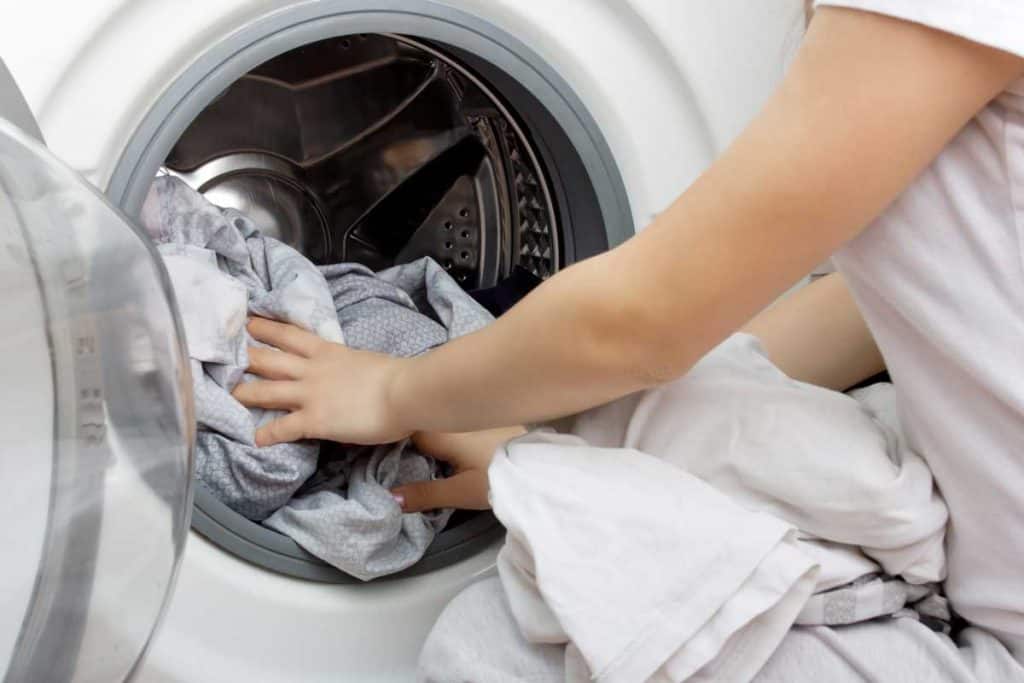Your shower curtain sees everyday use, which means it also sees everyday wear. Being able to clean it becomes necessary to a well-sanitized bathroom. All that soap scum and mildew shouldn't be left to accumulate, after all. So what can you do about it?
The short answer is yes, you can wash a shower curtain or liner. You even have a couple of options:
- Using a washing machine
- Or spot washing by hand
Which method works best for you—as well as what kind of disinfectant to use—depends in part on what's available to you and personal preference. Let's take a closer look at the steps required to wash your plastic shower curtain or liner.

How to Wash A Shower Curtain
We sometimes add affiliate links and content that was curated and created by our team with the help of advanced ai tools to help showcase the best design styles.

Step 1: Choosing a Disinfectant
Thankfully, shower curtains can be cleaned with substances found around most households. The most common cleaners are:
- White vinegar
- Baking soda
- Laundry detergent (though avoid heavy-duty products)
- Bleach
Of course, laundry detergent won't be of much help when it comes to spot cleaning, but you can use any one of these four products in the washing machine. Just don't try to combine them all.
Both vinegar and baking soda do an excellent job of removing odors, while detergent is typically perfumed. It doesn't so much remove as mask. Finally, the first three substances are safe for use around children and pets, but bleach should be used with a bit more caution and only on white or transparent curtains and liners.
Step 2: A Spot Test Never Hurt
To avoid damaging your shower curtain beyond repair, consider conducting a spot test. This is as simple as rubbing a bit of the product you intend to use into one corner. If discoloration occurs, go back to step one and choose a different disinfectant.
Step 3, Part 1: Washing in a Machine
Using a washing machine to clean your shower curtain is certainly the less labor-intensive of the two options. However, it does come with a bit of a risk. You'll want to check up on your curtain a couple of times during the cycle to make sure nothing has melted. A good tip to keep in mind: adding a few clean towels to the machine helps balance the wash and keeps the shower curtain from ripping.
Then, you can add a half a cup of baking soda or stick with laundry detergent at the start of the cycle. When the machine gets to rinsing, feel free to add in a half a cup of vinegar to really wash away the stains and sanitize the curtain.
What Temperature Should You Use?
The goal is to avoid damage, and you certainly don't want the shower curtain to melt in your machine. Set your device to warm water and the gentle cycle. This should keep your curtain safe.
Step 3, Part 2: Hand Washing
If you don't have access to a washing machine or if using one makes you nervous, hand washing works just as well. All you need is baking soda or vinegar, warm water, and a clean cloth.
You'll want to set the shower curtain down on a relatively flat surface, like sprawled out on the bathroom floor or draped inside the tub. If you're using baking soda, sprinkle some on your dampened cloth and then start scrubbing at the dirt. For vinegar, spray it directly onto the spot you want to clean before scrubbing away.
Use water to rinse off the curtain, and then repeat the process as needed to get rid of all the scum and mildew. For especially tough stains, you can spot wash with bleach.
Step 4: Drying
You should never put your shower curtain in a drier. Instead, hang it back up on the rod. Letting it drip dry is the best way to avoid damage. By the end of the day, the shower curtain should be clean and ready for use again. Just be sure to rinse out the tub before stepping inside.
Step 5: Maintenance
Keeping up with shower curtain cleanliness means an easier job next time you do a deep wash. For example, mixing a solution of vinegar and water to spray on your curtain after each use slows down the buildup of bacteria.
How Often Should You Clean Your Shower Curtain?
Frequency depends on how many people use the shower and how frequently scum and mildew build up. For shower curtains that see a lot of action,washing it once a month is ideal.
Perhaps a more reasonable goal is once every three months. A quarterly shower curtain clean keeps everything fresh and stops you from feeling guilty that you don't get around to the task more often.
How Do You Remove Hard Water Stains?
In the short-term, vinegar is useful for removing hard water stains. If cleaning it by hand or running the curtain through the washing machine isn't enough to make the stains disappear, you can try leaving your shower curtain to soak in white vinegar for a couple hours.
For long-term solutions, you can look into getting filters that soften your running water. This should stop stains from occurring or, at the very least, reduce the frequency and tenacity of the stains.
Should You Wash a New Shower Curtain?
The answer to this question depends in part in how diligent you are in your fight against bacteria. Washing a shower curtain before you hang it up means starting with a clean slate, which appeals to some people. Others are comfortable diving right into use.
One thing to keep in mind is that washing a shower curtain before using it has the potential to reduce mildew buildup. This makes subsequent cleanings a little easier.
How Do You Wash a Fabric Shower Curtain?
When it comes to fabric shower curtains, they generally have a tag attached that outlines care instructions. If you haven't cut this off, this is the first place to look when your curtain needs a clean.
Generally speaking, fabric shower curtains can be thrown in the washing machine. Follow the same general principles as you do when washing a plastic curtain. Including towels is still a smart choice, and rinsing with vinegar helps kill bacteria. Unless the tag states otherwise, using warm water is usually still the way to go, as well.
You can also choose to spot clean your fabric shower curtain. Baking soda will work just as well taking down scum and mold on fabric. The only difference, really, is that it might take a little longer to line dry.
If you don't already have one, you might want to pair your fabric shower curtain with a liner, the maintenance of which matches that of plastic shower curtains.
Happy Cleaning!
Since you should be cleaning regularly, you can always try out these different methods to see which works best for you. Once you have a system down, your bathroom will feel cleaner and fresher than ever!
